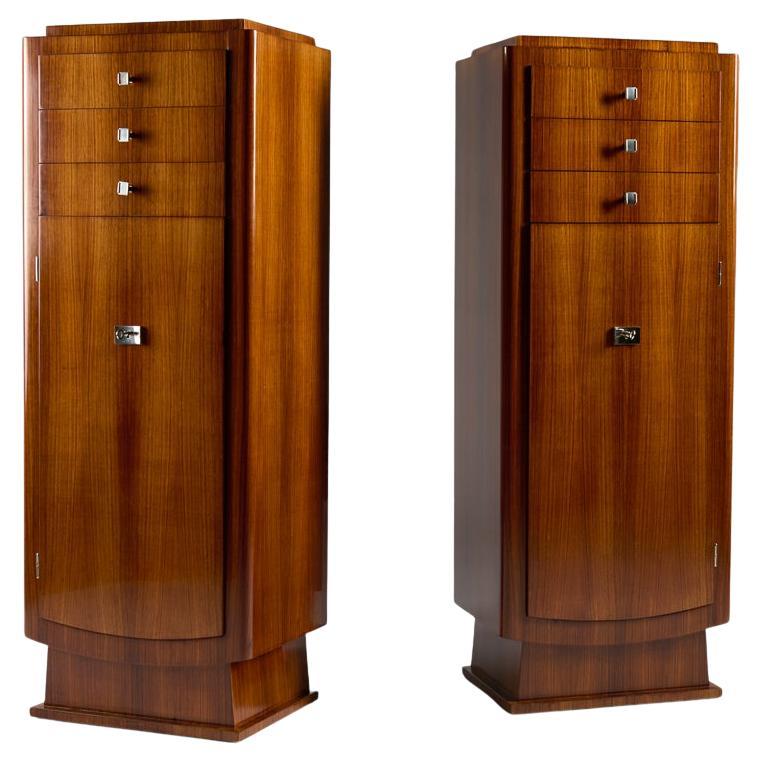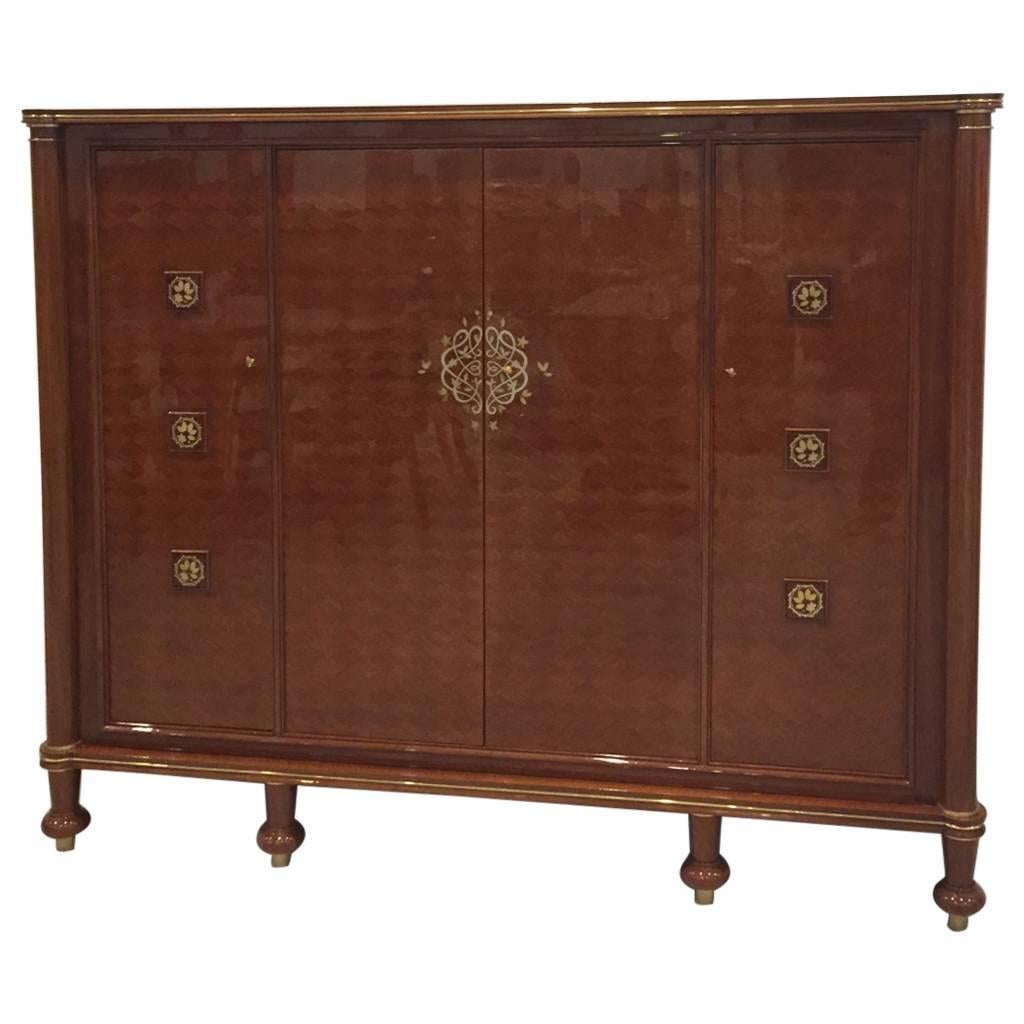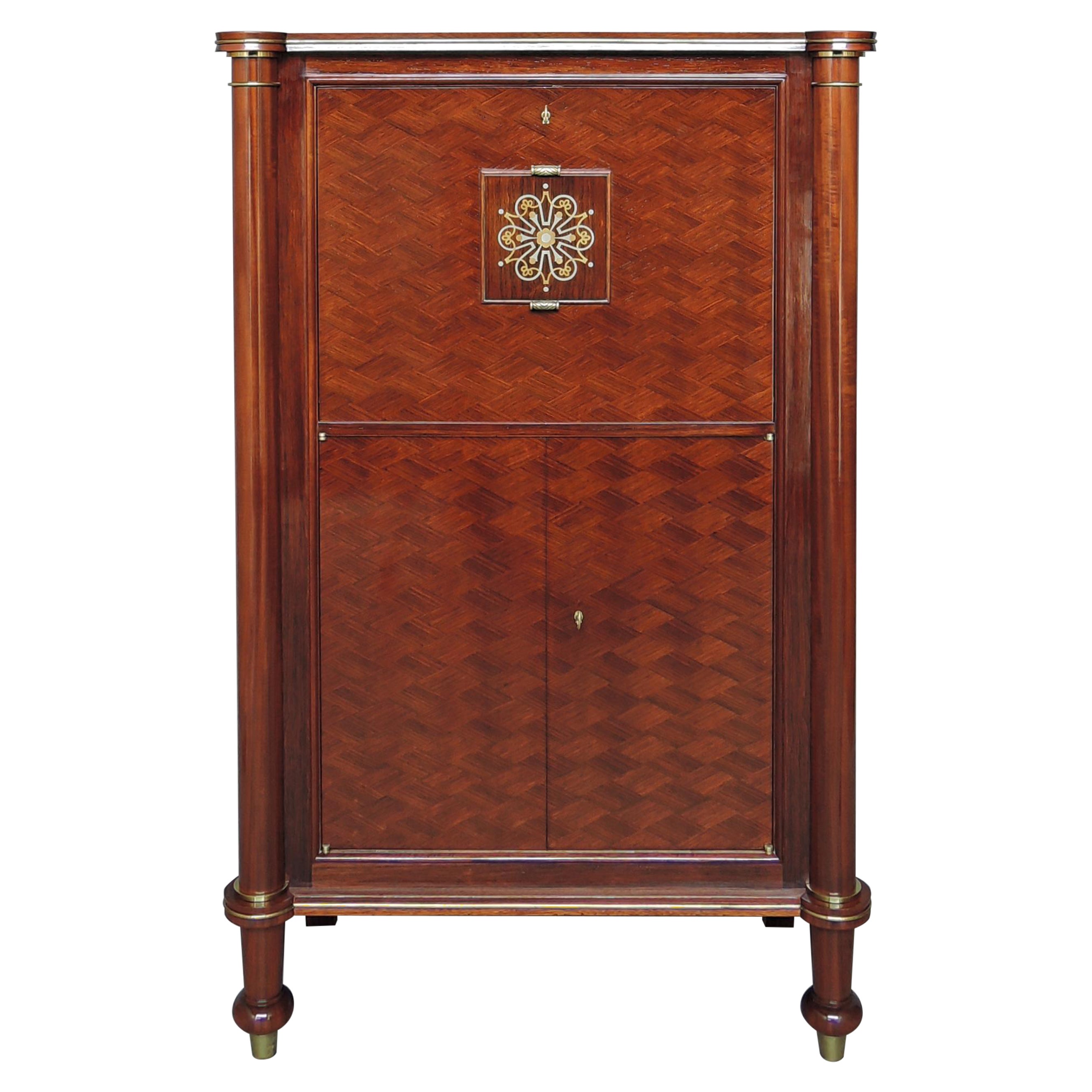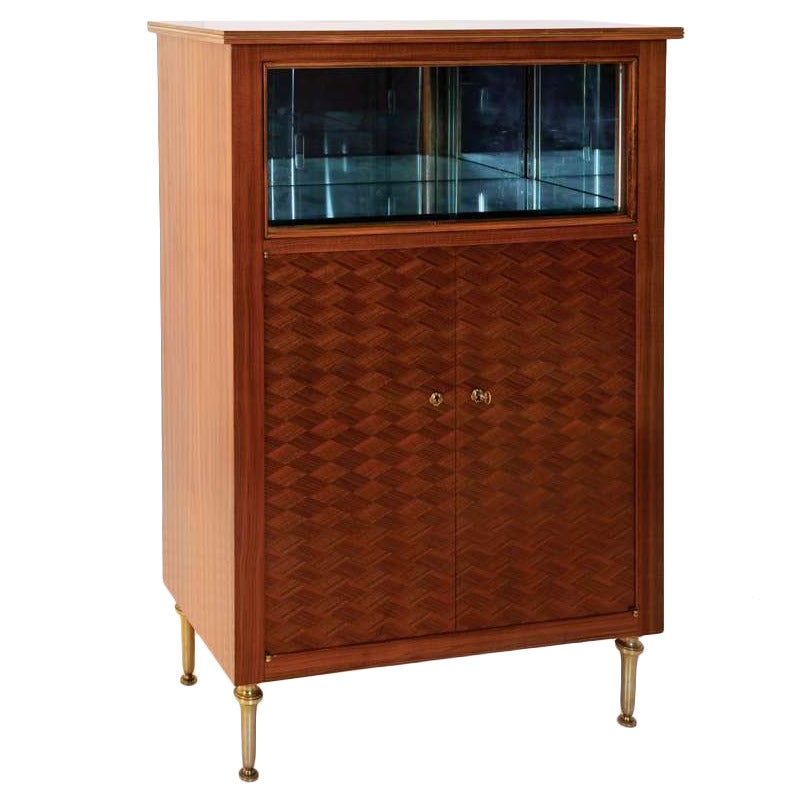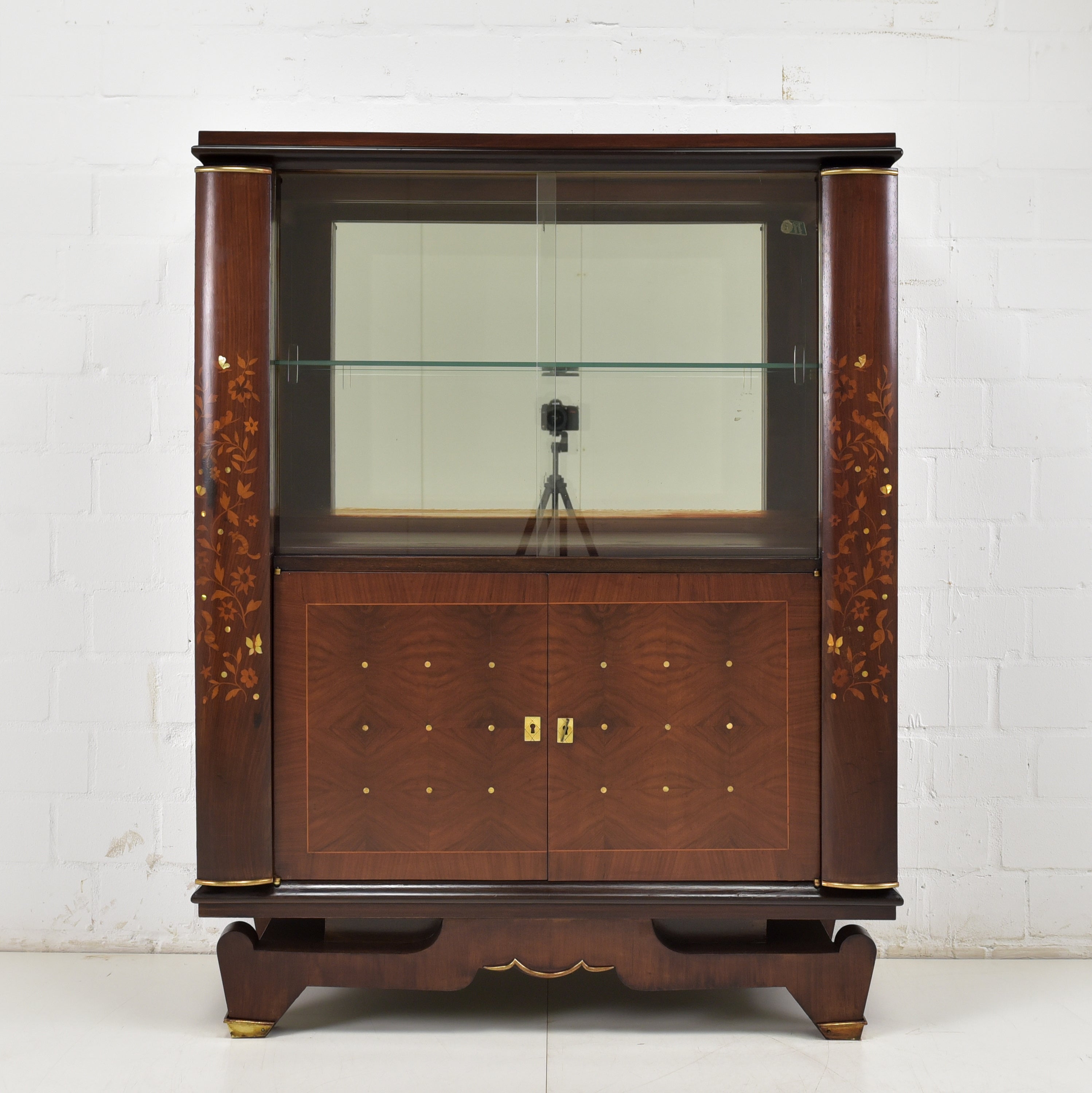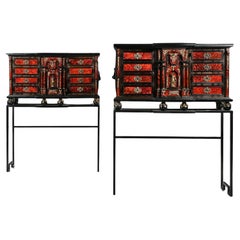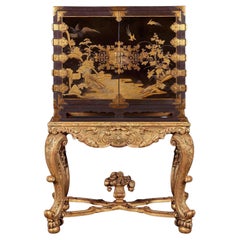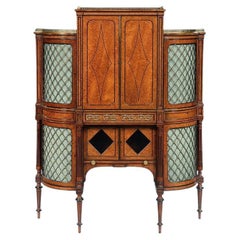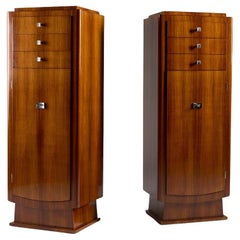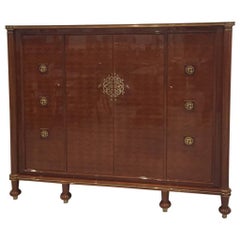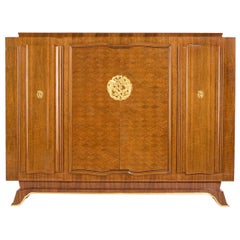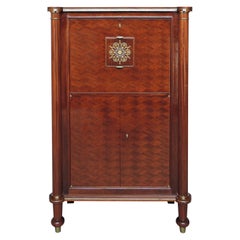Items Similar to Pair of French Art Deco Cabinets by Jules Leleu
Want more images or videos?
Request additional images or videos from the seller
1 of 7
Pair of French Art Deco Cabinets by Jules Leleu
About the Item
A Very Fine and Important Pair of Art Deco Commodes Firmly Attributed to Jules Leleu
French Circa 1940
These magnificent pieces are veneered throughout in walnut, laid in an extended parquetry pattern across the doors. The cabinets themselves are of inverted breakfront form with the central doors slightly recessed compared to the doors to either side. The side doors are of a complex undulating form which would have been very difficult to create, and particularly difficult to veneer.
These pieces were originally intended as dressing commodes and, as such, have mirrors behind the central doors. The mirrors act as cheval mirrors, meaning that one can stand in the middle of the three surfaces and see an outfit "in the round", very useful for the wealthy Art Deco lady putting together her latest showstopping outfit. The central mirror can then be opened to reveal a series of shelves and small drawers behind. The side doors conceal additional shelves, meaning that these pieces offer an abundance of storage options.
The commodes have typical Leleu overhanging form, the body of the pieces sat on shorter bases. Another Leleu feature that tends to appear on such pieces is a central mount to draw the eye, the master has chosen to use an interesting ormolu mount of a female bacchante and a faun which also functions as the escutcheon for the central section. Perhaps the bacchic subject was chosen because the lucky people who commissioned these pieces would essentially have been using them to dress to entertain, and Bacchus was associated with the concept of entertainment and revelry.
Although these pieces are not signed we have no doubt as to their authorship, based on numerous other pieces by Leleu that we have handled in the past. Furniture by the master is always sought after and pairs of cabinets, as opposed to singles, are almost never encountered, making these real collectors' pieces and of great interest to connoisseurs and decorators alike.
Jules Leleu
Jules Leleu who was of the one key figures in the Art Deco movement. His family firm of Maison Leleu had existed since the eighteenth-century and he helped to guide it through much of the twentieth century with his gallery at 65 Avenue Franklin Roosevelt in Paris in the very centre of the fashionable retail centre of the city.
Leleu exhibited at the prestigious 1925 Exposition des Arts Decoratifs, winning a Grand Prize there and one of his pieces was purchased by the Metropolitan Museum in New York (Acc.No. 46.93). He was also an active participant in the annual Salon DíAutomne and Salon des Artistes DÈcorateurs.
Leleu was a prolific ensemblier, with a large number of private and public clients including the French ocean liners, Ile-de-France, Atlantique, Normandie and France. Amongst other important commissions were a dining room for the …lysÈe Palace, and the Grand Salon des Ambassadeurs at La SocietÈ des Nations in Geneva, named the Salon Leleu, which is still in existence today. His pieces are highly prized and can be seen at the Metropolitan Museum in New York, the MusÈe les Arts DÈcoratifs, and Collection Mobilier National in Paris which holds over one hundred of his pieces.
Leleu is celebrated for his conception of refined antique furniture forms and precision craftsmanship. His furniture is generally spare and sleek. He made significant use of opulent materials that were a keynote of haute Art Deco design and favoured the use of woods with warm tones, such as amboyna, Macassar ebony, and as on this piece, walnut, all of which imparted richness and elegance. He had his own distinctive and sophisticated style, often sober and reflective of traditional French furniture design, but also modern in line and use of materials, and always in excellent taste.
At one time The New York Times wrote, “he was just as successful and probably more prolific than his better-known contemporaries.”
These beautiful haute Art Deco piece would make a stunning statement piece in any contemporary home.
LITERATURE
V.JUTHEAU ëJules & Andrew Leleuí (Olbia, 2000)
SALES
The highlight of Jules Leleu sales has to be the Grande Commode, constructed in shagreen, mahogany and gilt bronze which realised 198,750 Euros at Sothebyís Paris, 24 November 2010.
Dimensions
Width 82 1/2 inches - 210cm
Height 65 3/4 inches - 167cm
Depth 19 1/2 inches - 49cm
- Dimensions:Height: 65.75 in (167 cm)Width: 82.68 in (210 cm)Depth: 19.3 in (49 cm)
- Sold As:Set of 2
- Materials and Techniques:
- Place of Origin:
- Period:
- Date of Manufacture:1940
- Condition:Wear consistent with age and use.
- Seller Location:Benington, GB
- Reference Number:Seller: 30321stDibs: LU1183240555902
About the Seller
5.0
Vetted Professional Seller
Every seller passes strict standards for authenticity and reliability
Established in 1969
1stDibs seller since 2015
124 sales on 1stDibs
Typical response time: <1 hour
Associations
LAPADA - The Association of Arts & Antiques DealersThe British Antique Dealers' Association
- ShippingRetrieving quote...Shipping from: Benington, United Kingdom
- Return Policy
Authenticity Guarantee
In the unlikely event there’s an issue with an item’s authenticity, contact us within 1 year for a full refund. DetailsMoney-Back Guarantee
If your item is not as described, is damaged in transit, or does not arrive, contact us within 7 days for a full refund. Details24-Hour Cancellation
You have a 24-hour grace period in which to reconsider your purchase, with no questions asked.Vetted Professional Sellers
Our world-class sellers must adhere to strict standards for service and quality, maintaining the integrity of our listings.Price-Match Guarantee
If you find that a seller listed the same item for a lower price elsewhere, we’ll match it.Trusted Global Delivery
Our best-in-class carrier network provides specialized shipping options worldwide, including custom delivery.More From This Seller
View AllPair of 17th Century Spanish Baroque Gilt Bronze Mounted Cabinets on Stands
Located in Benington, Herts
An Exceptional and rare pair of 17th Century Spanish Baroque gilt bronze and metal mounted ebonised and tortoiseshell cabine...
Category
Antique Late 17th Century Spanish Baroque Cabinets
Materials
Tortoise Shell, Ebony
17th Century Japanese Lacquer Cabinet On French Giltwood Regence Stand
Located in Benington, Herts
An Extremely Fine and Very Important 17th Century Japanese Lacquer Cabinet on French Giltwood Stand of Regence Period circa 1680-1690
Provenance
Likely acquired by Herman Willem ...
Category
Antique 17th Century Japanese Edo Cabinets
Materials
Giltwood, Lacquer
Fine Regency Amboyna And Ebony Inlaid Gilt Bronze Mounted Shaped Cabinet
Located in Benington, Herts
Of outstanding quality, an early 19th Century Regency ormolu mounted amboyna and ebony shaped side cabinet on tapering legs
English circa 1810.
Finely decorated with ebony bea...
Category
Antique 19th Century English Regency Cabinets
Materials
Ebony, Amboyna
An Important 18th Century George Iii Satinwood and Sabicu Writing Cabinet
Located in Benington, Herts
A fine late 18th Century George III Satinwood and sabicu ladies writing cabinet with important provenance. (Possibly by George Simpson)
English London made - Circa 1785
Provenance
Exhibited by W. R. Harvey in their Old Bond Street showrooms in 1986 and 1987, the piece being chosen to be advertised in Country Life magazine in 1986 and in the Grosvenor House...
Category
Antique 1780s English George III Cabinets
Materials
Satinwood
An Important Late 17th Century Japanese Lacquered Cabinet Edo Period on Stand
Located in Benington, Herts
An extremely fine, elegant and rare late 17th Century Japanese lacquer cabinet, from the Eco period, on later lacquered black stand.
Japanese circa 1690
Provenance
A private Scottish collection
This outstanding cabinet is a fascinating fusion of east and west. The cabinet itself would have been made in Japan, c.1690, and is decorated to the outside with hiramaki-e lacquer. This technique involves the use of sprinkled gold powder which adheres to the lacquer surface. On the best pieces, as with this example, many layers are added in order to create areas of high relief and give depth to the surface decoration. The taste of the Japanese workshops in this period was often for quite restrained pieces with plenty of the black background visible, unlike some of the busier Chinese lacquer or European japanned examples produced around the same time. The Japanese makers seemed content to rely on the outstanding quality of the lacquer itself, regarded by most experts as the finest lacquer ever produced, and did not see the need to cover every surface believing that less was more in this respect. The lacquer here is used to produce a mountainous scene with buildings on the bank of a river, the other side of the river with more buildings and a contrasting flatter and forested landscape. The fine perspective achieved is the result of the clever use of raised and flatter areas in the lacquer itself in combination with the drawing of the design itself.
Another remarkable aspect of this piece is the fine metalware throughout, but particularly the lockplate / hasp, hinges and foot mounts to the front. This is all beautifully cast and engraved contrasting against the black background. Interestingly another cabinet on stand with near identical metalwork was advertised in the Burlington Magazine, November 1913, with the dealer W. Williamson and Sons of Guildford. The lacquer on that piece is similarly refined and it seems likely that both pieces came from the same workshop.
The European influence in our piece can be seen in both the later ebonised stand and in the japanned decoration which has been applied to the inside of the doors and is also very fine indeed. This consists of two panels with birds of prey perched on branches in colours set against a golden background. The cabinet has a recent Scottish provenance and so it is likely that the ebonised stand was made in Britain though such pieces were made throughout Europe as a way of quite literally elevating these imported pieces of eastern lacquer as in Japan these would have been used on the floor. Inside the cabinet there is a combination of more Japanese lacquer and lock plates and European drawer handles. Most of the lacquer drawer fronts incorporate mountainous scenes and birds in combination, with a few purely one or the other of the two subjects. Again the lacquer is in excellent condition and is of exceptional quality with multiple layers of relief used in one single scene in many cases.
As mentioned above, Japanese lacquer is the most technically brilliant of the eastern lacquers and, as such, was highly prized by collectors and connoisseurs throughout Europe when this piece was made. The acquisition of such pieces would only have been possible for a small group of incredibly wealthy individuals, largely royal or high ranking courtiers or merchants connected with the East India trade...
Category
Antique 1690s Japanese Edo Cabinets
Materials
Lacquer
Unusual Pair of French Art Deco Ebonised Armchairs in a Crushed Velvet
Located in Benington, Herts
A very comfortable pair of Art Deco 20th century ebonised armchairs upholstered in an off white crushed velvet.
French Circa 1930-40.
The ...
Category
Vintage 1930s French Art Deco Armchairs
Materials
Velvet, Wood
You May Also Like
Jules Leleu, Pair of Tall Art Deco Cabinets, France, C. 1930
By Jules Leleu
Located in New York, NY
These cabinets share striking details, such as hardware and finish, with a series of pieces specially created by Maison Leleu for the steamship L'Atlantique. These stunning pieces we...
Category
Vintage 1920s French Art Deco Cabinets
Materials
Bronze
French Art Deco Signed Jules Leleu Cabinet
By Jules Leleu
Located in North Bergen, NJ
This sunning French Art Deco cabinet is designed by famous artisan Jules Leleu. The cabinet reflects the craftsmanship and quality of the Art Deco period. The bronze trim is pictured...
Category
20th Century French Art Deco Cabinets
Materials
Brass
Jules Leleu, Art Deco Walnut Cabinet, France, C. 1944
By Jules Leleu
Located in New York, NY
Fine walnut four-door cabinet by Jules Leleu with bronze medallion by Champreix
For an illustration of an identical cabinet, see Mobilier et Décoration, no. 5. December 1946.
F...
Category
20th Century French Cabinets
Materials
Bronze
Fine French Art Deco Bar by Jules Leleu
By Jules Leleu
Located in Long Island City, NY
Jules Leleu (1883 - 1961) : A fine French Art Deco bar cabinet with palisander and metal marquetry, and brass mounted details. Interiors in sycamore, mirror and chrome.
Inlaid plaque...
Category
20th Century French Art Deco Dry Bars
Materials
Brass, Chrome
Jules Leleu Cabinet, France, 1956
By Jules Leleu
Located in New York, NY
Vitrine by Jules Leleu in mahogany marquetry with glass sliding doors and gilt bronze legs
Bears its original label dated Nov 9th 1956, and is numbered on the back: 28332
Prove...
Category
20th Century French Cabinets
Materials
Bronze
Art Deco Bar Cabinet Showcase by Jules Leleu in Mahogany France, 1930
By Jules Leleu
Located in Lüdinghausen, DE
Showcase restored Jules Leleu Art Deco bar cabinet mahogany France
Features:
Sliding door compartment with glass shelf at top, two doors at bottom
Very high quality processing
...
Category
20th Century Art Deco Cabinets
Materials
Mahogany
Recently Viewed
View AllMore Ways To Browse
Pair Cabinet On A Stand
Round Art Deco Mirror On Base
Haute Deco
Small Bronze Lady
Art Deco Ocean Liner
Large Round Art Deco Mirrors
Dining Room Breakfront Cabinet
Gilt French Bronze Lady
French Art Deco Dressing
Art Deco Macassar Ebony Cabinet
Bronze Faun
Antique Dining Room Breakfront
Normandie Liner
Pair Of Art Deco Side Cabinets
Art Deco Bronze Lady
Inverted Mirror
French Mirrored Cabinet With Drawers Antique
Art Deco Amboyna
